Facebook is still the dominant way to reach new customers for businesses who sell information products (We’re talking about online courses, membership sites and high ticket programs here).
Here at our agency we love running multi-channel campaigns, but Facebook is always the place we start and often where we see the most scale.
When you have the right Facebook ad strategy it can pay off big time.
Between Facebook and Instagram as ad platforms (both available through Facebook ads), there’s always someone new out there to connect with your brand who is looking for the problem you solve.
Because of Facebook’s ad targeting, algorithmic based optimizations and how easy it is to set up your first ad campaign this is the platform we always get started on.
If you’re looking for ways to get started and improve your Facebook advertising strategy for online courses we made this monster guide just for you!
First, we’ll go through what the goal of any good Facebook ad strategy should be.
Then we’ll dive into the crucial steps to keep in mind when you want to launch, optimize and scale an ad campaign on Facebook.
Table of Contents
The Full Funnel Strategy For Facebook Ad Campaigns
When you’re thinking about starting a Facebook advertising strategy for online courses or an info product, you need to keep that your strategy has to engage users at every step of the customer journey.
For most businesses out there your future customers are already aware of a problem in their lives, but they don’t know you exist or that you are the best choice to solve that problem.
To help your brand enter their minds as the solution we implement what we call the full funnel strategy.
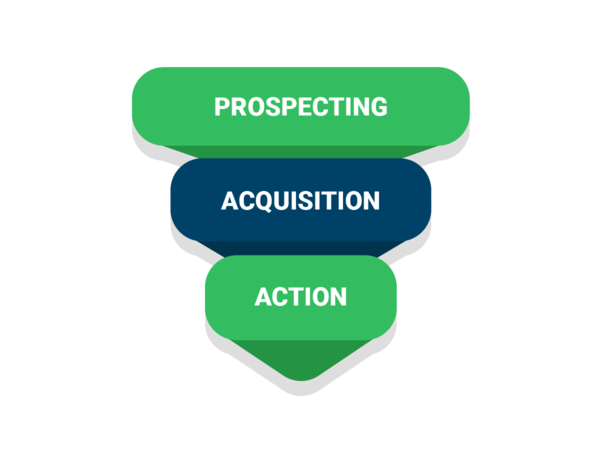
When you use a full funnel strategy your ad campaigns help move people through each step to help them find the products or services you offer that they may need:
- Prospecting: This is where you run campaigns to connect with people on the platform and introduce your brand. You can video ads, have freebies they can engage with and create content that gets you in front of them.
- Acquisition: This is where we run campaigns that get people to raise their hands and sign up for your main funnel with webinars and video trainings. Here we want to move people off the Facebook platform and get them into your main funnel to buy whether that’s a webinar, a sales call funnel or self liquidating offer.
- Action: Here is where we want to get customers to decide to sign up for what you’re selling. This is where we retarget people who are inside your funnel and get them to take action on the next step to become a customer.
Your main goal with advertising is to get new customers and make money.
That’s how your business stays alive and grows.
But we’re advertising on a social platform.
You want to start by being social and then bring in the sales message over time.
With a full funnel ad strategy you have a way to introduce your brand in a personal way and easy way.
Your goal is to create high converting ads at each step of the funnel that turns traffic into leads and leads into sales.
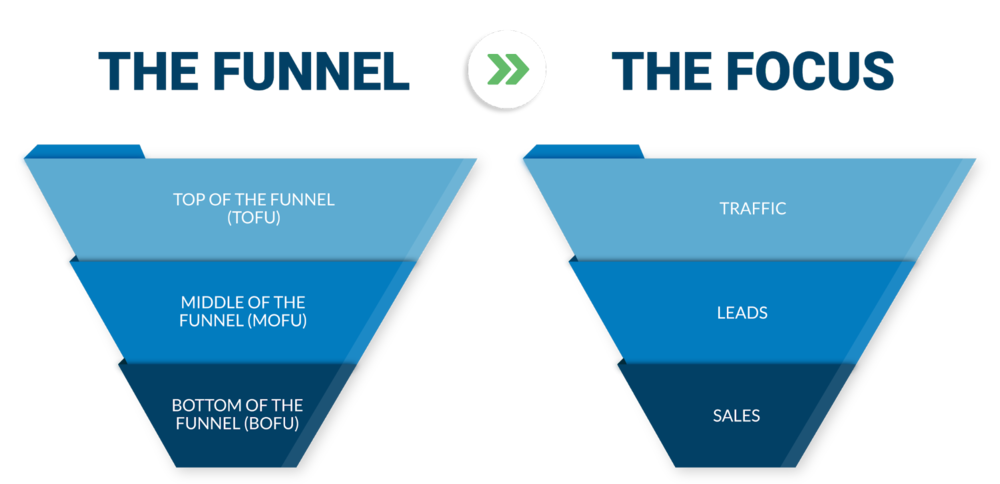
We never expect just one ad is going to do all the work.
For effective advertising we need to increase the number of people who are aware of your business through prospecting and get them to raise their hand and opt into your funnel through acquisition.
Then we can bring in the sales message at the final action stage get them to sign up for your courses and programs.
How To Find Your Customers With Facebook Ads
One of the most important parts of dialing in a solid Facebook ad strategy is understanding how to use their audience targeting capabilities.
Facebook has pretty much revolutionized the way traditional Pay-Per-Click (PPC) and ad targeting models work.
You used to decide on the websites that you thought your prospects would be on and decide to show your ads by the URL.
So if you thought your customers would read Foundr magazine you would choose to advertise on founder.com.
Today, Facebook allows you the advertisers to specifically choose the type of person who sees your ads.
It’s critical to get this right because showing your ads to the wrong person is a sure fire way to fail at Facebook advertising.
First, we’ll give you some tips about what you should look for when creating an audience.
Once you’ve done that, you can start thinking about more complicated ad strategies.
Creating A Target Audience
Facebook gives you the option to create an audience based on whatever criteria you choose. You can set such parameters as:
- Demographics: you can target potential customers based on demographic segments like type of work, education level, relationship status, and financial situation, to better help you choose the best target consumers.
- Age: by setting a smaller age range for your target audience, you can choose consumers who are more likely to click on your ad rather than a wide age range that may result in fewer sales conversions.
- Interests: Facebook tracks the “likes” and activity of its users on its platform, which comes in handy for advertisers. You can choose to advertise to people who liked or were active on pages devoted to a product or activity.
- Location: the location function on Facebook ads is vital for small businesses who want to target people in their locale, but this function is also useful if you’re targeting a region for a specific purpose.
When you’re just getting started this can seem like a lot to decide from, so here’s an example about how to do Facebook ad targeting for infoproducts right.
Let’s say you’re offering an online course for the basics of a coding language like Python.
An example of a demographic quality you should look to target is already works in the technology sector.
You could also select interests that are focused around “coding” or “computers.”
You could go one step further and target interests around what people can do with python, like “app development”.
If you’re offering higher end online courses in English, you could set the geotargeting to be in the United States, Canada, the United Kingdom and Australia.
As for age parameters, maybe you already know your best customers are between 25 and 45, so you could start there as the parameters for age targeting.
Boom! You got your first audience.
Want to approach it from another angle?
Test people who are in the phase of career switching for someone who might not be a coder now but could be interested.
Now you’ve got a second audience to test and compare the results between the two.
Lookalike Audiences
Lookalike audiences are one of the most powerful features offered by Facebook that helps you reach customers with parameters you may not have thought to add.
It’s basically like saying “Hey Facebook, here’s a list of my best customers. Go find me more people like these.”
You give Facebook a source audience that has more than 1,000 people on it and Facebook uses its algorithm to sift through the source audience’s likes and interests to find the people on the platform most like those users.
You can load up a list of customers, your email list, or even create them based on people who visit certain pages of your website or engage with you online.
This is consistently one of the best audiences we find for our Facebook ad targeting.
Retargeting Ads
Retargeting ads on Facebook are ads that target an audience of consumers who have interacted with your business in the past.
Instead of setting targeting brand new people online you can target people who have liked your ad, viewed your Facebook page, visited your website or are on your email list.
These are what you will use in both the Acquisition and Action stages of the funnel.
When you use these in your Facebook ad strategy you’re targeting people who already know you and have some familiarity with your brand so they are much more likely to convert.
Setting Up Right Facebook Ad Campaigns
Here’s a quick reminder: your ultimate goal is always to attract new customers without losing money.
To do that, you need to get someone’s attention, get them interested in what you have to offer and then get them to pull out their credit card and pay for it.
Each of these goals corresponds to a Facebook ad campaign.
Choosing the right facebook campaign objective here is super important.
Facebook and its machine learning algorithm are pretty good at getting you exactly what you ask for.
With the right strategy and the right campaign objective you can tap into Facebook’s algorithm and the natural way people buy to crank up your sales and make Facebook super profitable for you.
[optin-monster slug=”rfbaktwcdzgbbcr0gxwq” followrules=”true”]
Prospecting Campaigns To Create Awareness
Prospecting campaigns are super important to getting new people introduced to your brand and offer.
This is the first step in your Facebook ad strategy that will drive more revenue down the line.
You’re working to create awareness at the top of the funnel and increase the number of people who know about you so you can sell later.
These campaigns’ goals aren’t necessarily to drive sales (although they definitely do).
The goal is to get your business in front of new potential customers.
One strategy for an awareness campaign is to show someone an ad to download a free lead magnet you offer, like a mini explainer or how-to guide.
In this case, choose conversion campaigns and optimize for your specific conversion even.
If your goal here is just to watch a free video right on Facebook you can choose video views.
Want them to read an article on your website? Optimize for traffic.
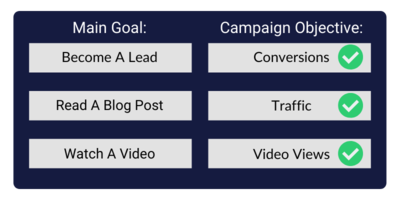
When they consume some of your content, they get to know you better and tend to convert better down the line.
Acquisition Campaigns To Generate Leads
The only way to really get sales is to get people to opt in for a funnel that starts selling what you have to offer.
You’re getting them off the ad platform and into your sales funnel.
And that’s exactly what acquisition campaigns are for.
The three best types of funnels for selling information products like courses, membership sites and high ticket programs are:
- Self liquidating offers
- Webinar Funnels
- Sales Call Funnels
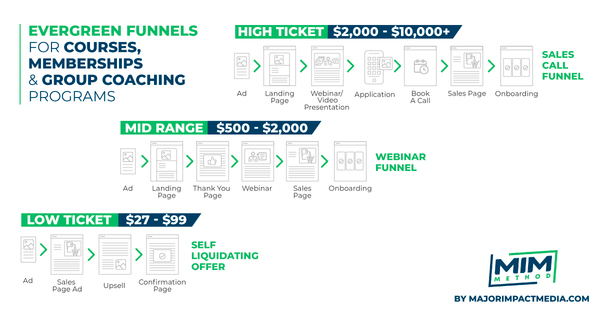
It is absolutely possible to drive people straight into your main funnel without doing a prospecting campaign first.
But your success will depend on things like how strong your funnel converts, how much brand awareness and authority you already have in the market and how competitive it is out there selling products like yours.
If you’re just getting started skipping straight to acquisition can lead to spending more money per lead than if you run a strong prospecting campaign first.
Really the only way to find out is to test it.
So how do you run acquisition campaigns to get people in your funnel to generate more leads?
If you’re selling an online course my favorite funnel is a webinar funnel.
We have done millions of dollars in sales for online courses by driving Facebook ads to a webinar funnel.
To use the coding example again, you could offer a free training on the big opportunity there is to learn this coding language and how to get started.
All they have to do to sign up is register with their email address.
When you do this you are building your email list with people interested in the topic and becoming the one who educates them about how to get to the next step.
Here you will pretty much use the conversion objective 90% of the time.
You want to tell Facebook to go find the people who will opt into your funnel and eventually buy.
And at this stage you can test different ads, audiences, different landing pages and even different offers to find out what resonates best to attract the kind of customers you want for your business.
Action Campaigns To Drive Sales
Here is where it’s time to turn all this effort into real revenue and sales for your business.
These campaigns are meant to increase the number of sales or ad conversions your campaigns produce.
Once someone has opted in for your funnel that sells your group coaching program, membership site, or online course it’s time to convert them into sales by showing them the benefits of your product.
These campaigns target customers who have started in the funnel but didn’t end up buying anything yet.
You can show them the benefits of your product, address objections they have, share with them other testimonials and case studies from other students of yours and show them why they should sign up now.
The more someone sees your ads the more likely they are to purchase your product or service.
That’s why these targeted action campaigns are for people who are already aware of your product and are close to buying.
How to Set Up Your Facebook Ad Campaign
Once you’ve determined who your ads are targeting and what sort of campaign you want to run, you can start putting your campaign together.
Before you get started, you need to make sure you have a Facebook Business Manager account.
If you don’t have one, you can set up an account by following the instructions here.
Once you’ve created an account or logged into your existing one, you can start creating campaigns!
The first step is to click on “Ads Manager” from the screen’s top-left corner. Now that you’re in the right place, follow these steps to launch a campaign:
- Locate the “Create” button in the top left corner and click on it
- Select your campaign goal (conversions, traffic, video views, etc.).
- Give your campaign a name that will make it easy to recognize later
- Create your first ad set. This is where you choose your targeting
- Name your ad set (who are you targeting here?)
- Choose your target audience by either creating a new audience or using a saved custom audience
- Select ad placement at the ad set level. Although Facebook typically recommends “Automatic Placements” we ignore that and go with Facebook and Instagram to get started
- Create your ad. Choose your copy, images or video and where the ad links to.
- Give the ad a good name so you can tell that one from the others later.
- Make a few more ads to start testing.
Obviously that’s not an exhaustive guide for launching a Facebook ad campaign, but that will give you a basic framework of how to get started.
What Makes A Good Facebook Ad
When you’re creating your Facebook ad strategy, your ad is one of the most important parts of the whole equation.
It doesn’t matter if you have the perfect ad targeting, if your ads are boring and blend in no one is going to pay attention to them.
If you include these five components in your ad, you have a better chance of turning traffic into leads or leads into sales.
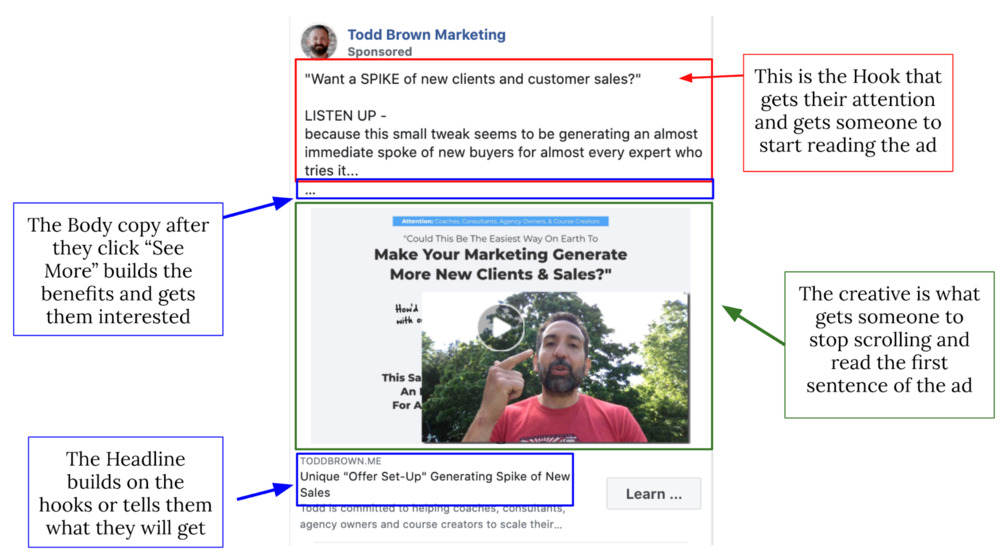
The Image
An image will draw the most attention to your ad. When people are scrolling on Facebook, this is what is going to stop the scroll and get them to read the first sentence of your ad.
The Body
Your ad’s body is the place within your ad where you’ll write your conversion focused copy.
This includes the first sentence of your ad that people will see so make sure it’s good.
We find long form copy work best for information products like online courses and membership sites.

Make this copy exciting, entertaining and engaging. That’s the only way someone will stop and pay attention.
The Headline
The headline, usually bolded in most placements, is the largest text in the advertisement. The headline is an ideal spot for you to highlight what your product or service is.
Keep this really congruent with what’s on the next page so people know what they are getting when they click.
The Description
The description section is the small blurb of text below your ad’s headline.
You should use this section to help persuade someone interested in your product but hasn’t decided if it’s the right fit yet.
It’s just a little bit of extra motivation to convince someone who’s on the fence about clicking.
The Call to Action
Most Facebook ads have a call to action button. And this is what someone is going to click on to go to the next step.
Most of your ads will take someone to the next page of your funnel, so give it an action that will be relevant to what happens next.
Maybe it’s a “Sign Up”, “Download”, “Learn More” or “Buy Now” button depending on the next step.
Testing Your Facebook Ads
Once you’ve hammered out all the details of your Facebook ad strategy for your infoproduct or online courses, you can test what ads work best for the customers you’re trying to attract.
Every ad has a few different variables you can change to see what works best to attract customers.
When you’re testing out your ads, it’s important that you change one variable at a time.
If you change multiple variables during a test, you won’t know which change caused the increase or decrease in traffic.
The most common variables you can change in an ad campaign are:
- The hook or big idea of the ad
- The image
- The video
- The body copy
- The headline
- The description
- The call to action
- The audience
Every stage of your full funnel strategy needs to be tested and optimized.
So instead of turning on your ads and asking if it made money or not you can test to find the right combination of variables that works for your online course, infoproduct, or membership site.
That’s how you get the best results over time.
Tracking The Right Facebook Ad Metrics
There are a ton of metrics inside the Facebook ad platform.
You do not need to know and use them all when you are getting started
Understand the important metrics and it will help your advertising campaign stay profitable.
Here are the most important metrics to keep track of:
- Impressions: the number of times your ad appears on a potential customer’s screen
- Click-Through Rate (CTR): the percentage of people who saw your ad and clicked it
- Cost-Per-Click (CPC): the rate you pay every time someone clicks on your ad
- Cost-Per-Lead (CPL): the rate you pay every time someone gives you their email
- Cost-Per-Acquisition (CPA): the rate you pay to acquire a paying customer
- Conversion Rate: What is the percentage of people who go from one step to the other
- Return on Advertising Spend (ROAS): the amount of revenue from ad traffic divided by your total advertising costs gives you the ratio of how much revenue you generate from each dollar you spend
- Margin: What is the difference between your cost to acquire a new customer and what it costs you to deliver that product / service. Take your gross profit and divide it by your total sales revenue.
Out of all these metrics, ROAS and margin are the most important to keep in mind.
If your ROAS is unacceptable the other metrics don’t matter.
Always focus on getting your ROAS to an acceptable level then work on decreasing your CPC or CPA over time.
The longer you advertise and the more comfortable you get with the metrics you can start to track more numbers.
Better metrics help you make better decisions to grow your business.
Scaling Up Your Facebook Ad Campaigns
If you’re new to advertising you don’t have to dive in and spend tens of thousands of dollars to get started.
Actually what’s awesome about Facebook is that you can start slow and with a low budget.
It’s better to run a few small campaigns that learn what works rather than one big campaign with high costs that end up failing.
You’ll get a ton of great feedback from the smaller campaign, and you can use that knowledge to make sure your future campaigns are profitable.
For your first round of Facebook ads, we recommend setting aside a certain amount of money you’re willing to spend.
Think about this money like you’re buying data from the marketplace.
If you make some money back, great! But that’s not the goal.
You’re learning what strategy, ad copy, images and targeting are going to work for your business in the campaigns you will launch down the road.
Let the numbers tell you what your customers like and what works.
Don’t get attached to certain ad copies or images that you like.
Ultimately the market will decide what it wants.
You should be willing to change any part of your Facebook ad strategy if the data shows it’s keeping you from getting better results.
When you do this right you can make a major impact on your business with profitable and effective advertising.
What’s Next?
Now that you know the foundations of a Facebook advertising strategy for online courses, you can get started planning out your full funnel strategy.
If you’re looking to start acquiring new customers with Facebook ads, hopefully this guide gave you an outline for how to get started with the best strategy for online courses, membership sites and high ticket programs..
Now the best way to actually learn is to get your hands dirty and get started!

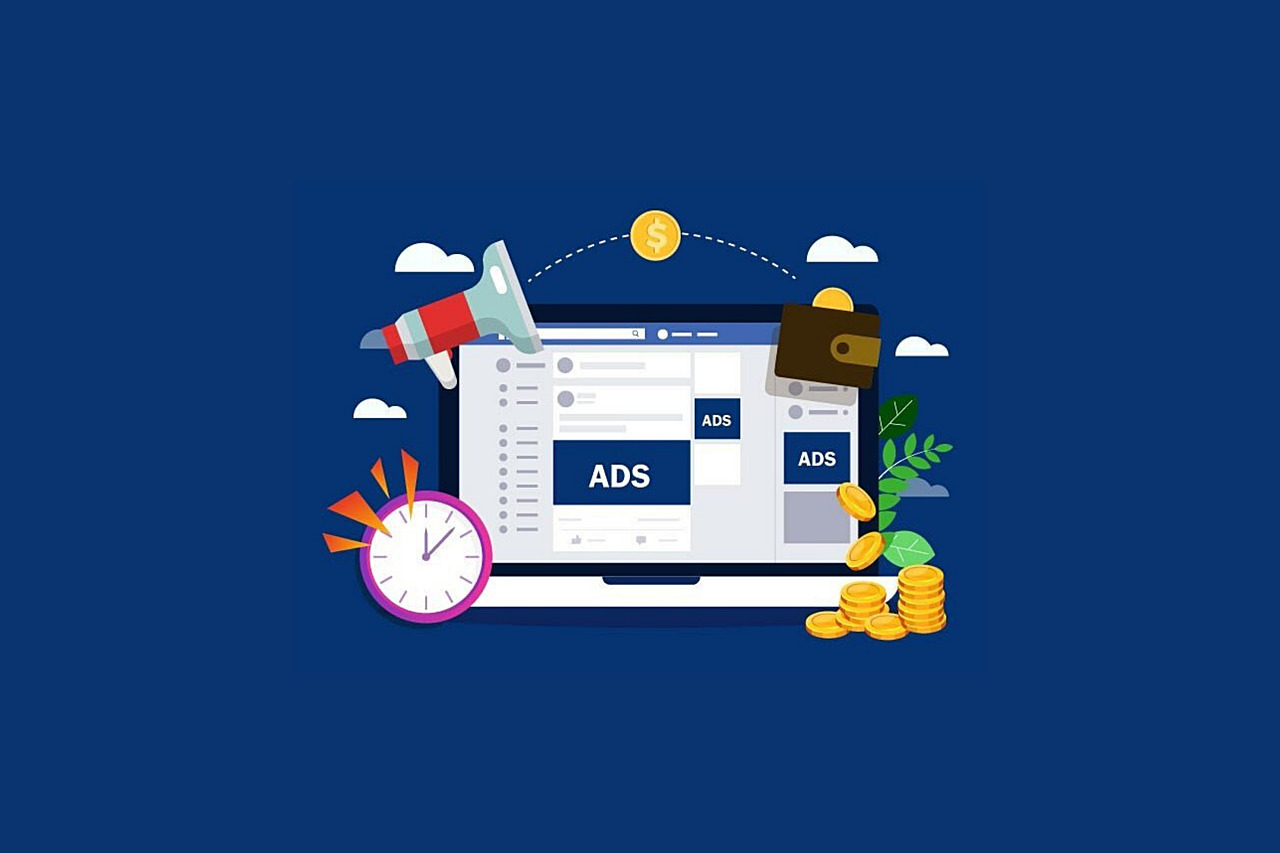
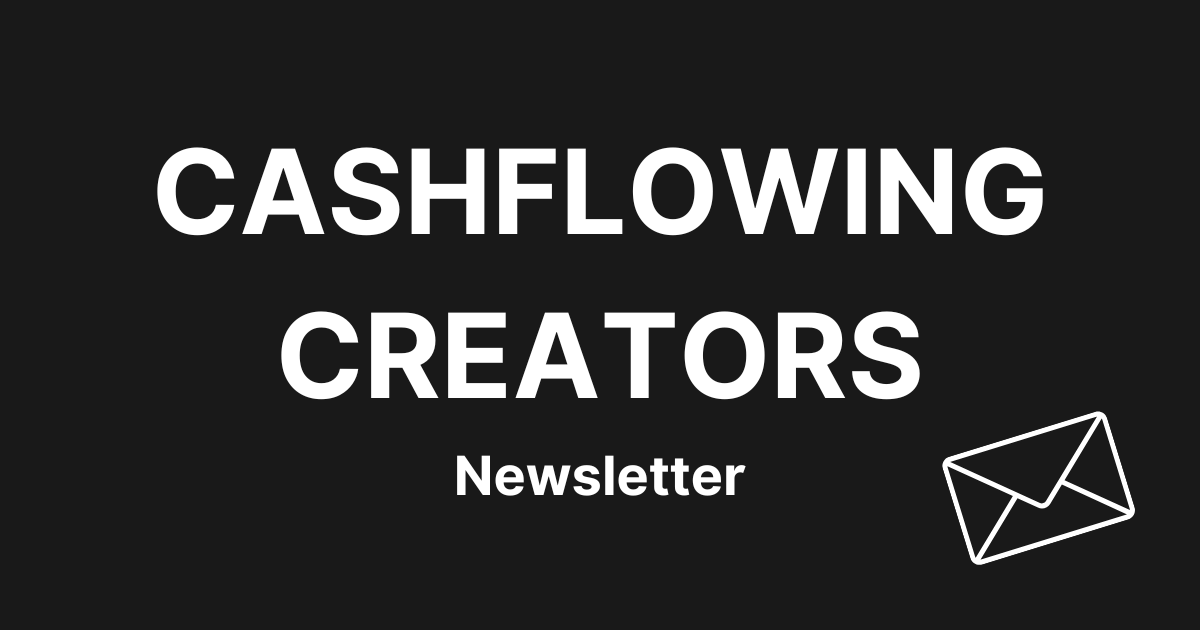
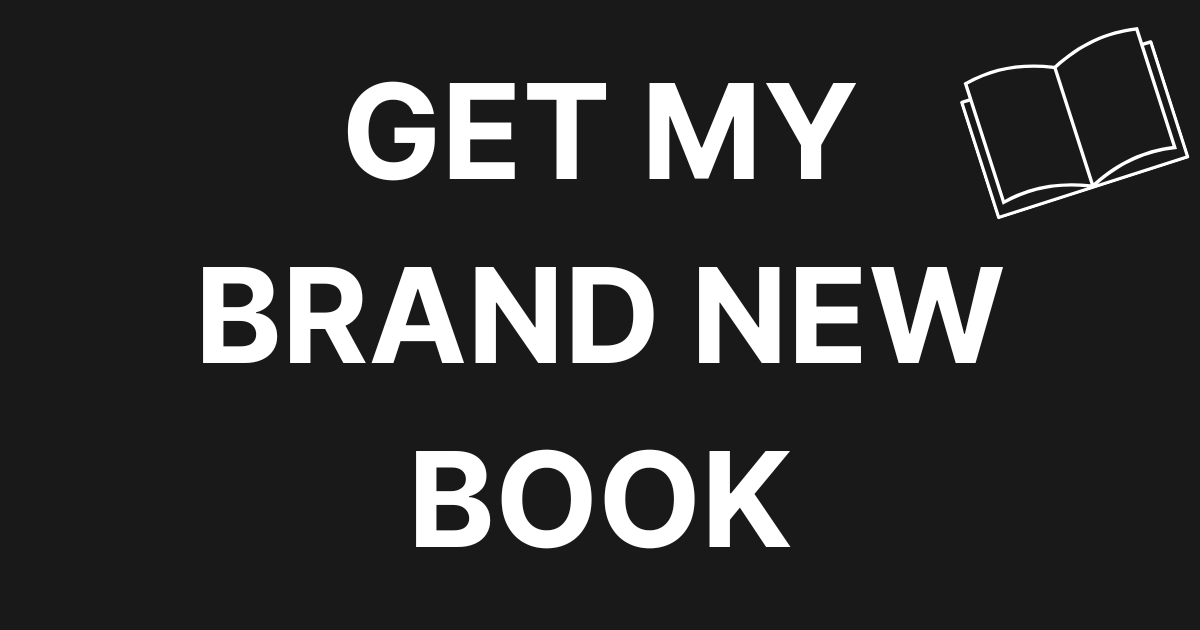
0 Comments